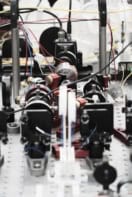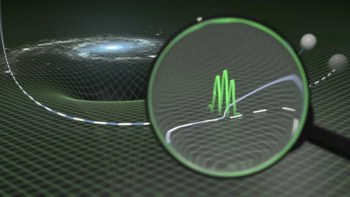Physicists in the US have managed to entangle two individual atomic ions that are one metre apart. Their system, which is the first to uses photons to remotely entangle a pair of atomic ions, could pave the way for the construction of practical quantum information networks (Nature 449 68).
Unlike classical bits of information, which must take either the value 0 or 1, quantum bits or “qubits” can assume a mixed-up superposition of the values 0 and 1. Furthermore, two qubits can be entangled so that the value of one qubit is revealed by measuring the value of the other. Although these odd properties have spawned an array of applications such as quantum encryption, future devices will hinge on the ability to remotely entangle qubits in a network that have already been separated by large distances.
Ideally atoms would be used to store qubits because they would remain stable over long timescales, while photons — which can travel undisturbed over long distances — would entangle them. Now Chris Monroe from the University of Maryland and others from the University of Michigan have demonstrated that photons emitted towards each other from separated atomic qubits can — after they have met midway — entangle the qubits from afar.
In their experiment, two atomic ions trapped a metre apart by electric fields are excited into a higher energy state using a pulse of laser light. Moments later, each ion falls back into one of two distinct energy states while emitting a photon of a corresponding frequency that can show what the new state is. Both of these photons are captured by a lens and guided towards each other along fibre optics.
At the ends of the fibres the photons meet at a beamsplitter, and if they are the same frequency they interfere. Monroe and co-workers can then detect the photons at the two outputs of the beamsplitter, from which they learn what the atomic states are. However, because they cannot know what ions these states belong to, the ions are left in a superposition of the two possibilities — in other words, they are left entangled.
The Michigan team can prove this entanglement exists by using another laser to probe the two ions, which fluoresce differently depending on their state, for signs of correlations. Over many experiment runs, they found that the correlations persisted, even when the ions were “rotated” to satisfy all the statistical conditions. “Useful entanglement of such states of matter has never been established before over such a distance,” Monroe told physicsworld.com.
The system may not have practical applications just yet, however. The losses in the apparatus conspire to produce an entanglement probability of about 10-9, meaning the researchers only get a successful entanglement every few minutes despite repeating the process a million times a second. Moreover, the near-UV photons required are of high loss in optical fibre, which limits the system’s long-distance potential. “We are looking at the possibility of efficiently converting these photons to more friendly — or even telecom — wavelength, where they could safely go many kilometres,” Monroe said.



